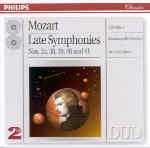There are remarkably few first-class recordings of Mozart’s last two symphonies currently available. This is one of them, and then some. I well remember my surprise, back in 1982 when Symphonies Nos. 39 and 41 were released, at how marvelous these performances sounded–arguably the best since Szell’s. And how, at a time when digital technology was new and Philips’ engineers were turning out one sonic catastrophe after another, several with this very conductor, the folks at Deutsche Schallplatten, working in familiar surroundings with (at the time) the greatest orchestra in both Germanys, captured these works with perfect balances, exemplary warmth, and pellucid clarity.
There’s no need to go into excessive detail about the individual performances, since the same qualities pertain to all. Colin Davis sets naturally flowing tempos that allow the players to articulate Mozart’s many notes with maximum rhythmic emphasis and characterful phrasing. Even where his speed may seem a bit slow, as in the finale of Symphony No. 40, the sheer energy and gusto of the playing justifies his choice. Orchestral balances, winds well to the fore, add gorgeous washes of color to Mozart’s sensuous textures (I’m thinking here of the Jupiter Symphony’s slow movement, and the marvelous “German dance” finale of No. 39).
When it comes to repeats, Davis happily follows the traditional modern practice of observing first-half (exposition) repeats only, thereby preventing the odd sensation of hearing each ending twice and stretching out the slow movements to epic lengths. One of the more disgusting habits arising from the “period-instrument” school (one that has infected many traditional performances as well) is mindless acceptance of the idea that every repeat must be observed, irrespective of the frequent inability of the performers to turn a phrase or sustain a long, legato line. You won’t find that problem here: Davis knows exactly where he’s going, and the Dresden players follow him to a man.
If I had to summarize everything that is most wonderful about these performances, I would direct your attention to the firm, vibrantly present, shapely bass lines at the end of the exposition of the Jupiter Symphony’s finale. This is one of those rare instances where great playing and insightful interpretation, perfectly supported by an ideal acoustic and superb engineering, come together to give the music a feeling of “rightness” akin to Natural Law. It’s a moment that says more about Mozart and the true Classical style than the sum of every period-instrument performance ever released. [8/3/2002]
































